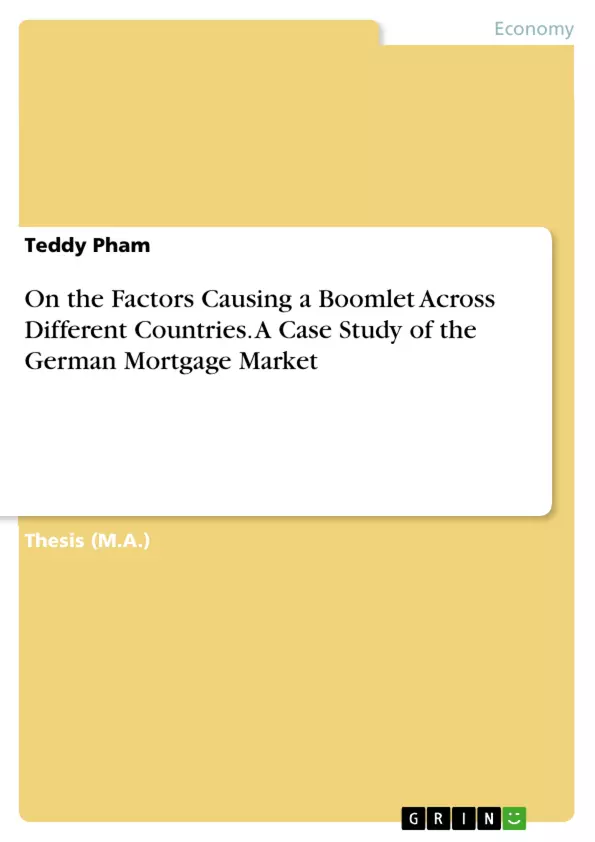The goal of this thesis is to find and to analyze the factors that ignited the housing bubble across different countries and to apply them to the German mortgage market. The reason for research is that the global financial crisis emphasized the risks associated with real-estate booms.
In any great financial crisis, the mortgage boom was buoyed by the housing rise and economic activity. When that spiral inverts, falling house prices make tightened lending standards, which bring to widespread failures and debt overhang. The consequences are recessions and high surges in public debt. The thesis is composed of four chapters, each of them dealing with different perspectives of housing boomlet and macro-financial factors.
The purpose of this thesis is to define whether there are also housing bubbles within the German mortgage market, as well as to find out which factors prevent Germany from a housing bubble. In order to do so, secondary data from prestigious financial institutes will be analyzed. The result is that there is no housing bubble in Germany at the national level, but that there has been a housing bubble in several cities. Fusions of macroprudential policy (loan-to-value), monetary policy (interest rate) and other housing financial characteristics (term to maturity, cost of registering property, and tax deduction) are buffers to stop housing boomlet. In conclusion, the German mortgage market has not been affected by the United States’ housing bubble because of the difference in manipulating macroprudential policy and housing financial characteristics.
Inhaltsverzeichnis (Table of Contents)
- Preface
- Executive summary
- Chapter One
- Rationale for the topic
- Research aim
- Methodology
- Chapter Two
- Monetary policy of European Central Bank (ECB)
- Macroprudential policies
- Housing bubble and the consequence
- Recommendation for the case study of Spanish housing bubble
- Case study of “housing finance and real-estate booms”
- Case study of “speculative price bubble in Urban housing market in Germany”
- Empirica-Blasenindex I/2014
- Chapter Three
- Analysis of housing markets in two biggest economies: the United States & China
- Comparison of Spanish housing bubble causes with German housing bubble causes
- Housing finance and real-estate boonm
- Speculative Price Bubbles in Urban housing markets in German
- Empirica Blasenindex I/2014
- ECB's monetary policy & macroprudential policy
- Chapter Four
Zielsetzung und Themenschwerpunkte (Objectives and Key Themes)
The primary objective of this paper is to identify and analyze factors that contribute to housing bubbles across various countries, focusing specifically on the German mortgage market. The paper explores the potential for a housing bubble in Germany, investigates preventative measures, and examines the impact of global financial crises on real estate markets.
- Factors contributing to housing bubbles
- Housing bubble prevention strategies
- Macroprudential and monetary policy
- The impact of global financial crises on real estate markets
- Case study of the German mortgage market
Zusammenfassung der Kapitel (Chapter Summaries)
Chapter One introduces the rationale, research objectives, research questions, and methodology employed in the thesis. The chapter is divided into three sections, exploring the motivation for the research topic, defining the research goals, and outlining the methodological approach.
Chapter Two delves into a comprehensive literature review on housing bubbles. This chapter examines various aspects, including the monetary policy of the European Central Bank (ECB), macroprudential policies, the consequences of housing bubbles, recommendations for addressing the Spanish housing bubble, case studies of housing finance and real estate booms, and an analysis of speculative price bubbles in the urban housing market of Germany. The chapter concludes with a review of the Empirica-Blasenindex I/2014.
Chapter Three presents discussions and analyses of housing markets in two major economies, the United States and China. It compares the causes of the Spanish housing bubble with those of the German housing bubble, further analyzing "housing finance and real estate booms," "speculative price bubbles in urban housing markets in German," and the "Empirica Blasenindex I/2014." The chapter also explores the role of the ECB's monetary policy and macroprudential policy, offering a fresh perspective.
Schlüsselwörter (Keywords)
The paper centers around the themes of housing bubbles, mortgage markets, macroprudential policy, monetary policy, real estate booms, financial crises, and case studies, particularly focusing on Germany's mortgage market and the impact of global financial crises.
- Arbeit zitieren
- Teddy Pham (Autor:in), 2018, On the Factors Causing a Boomlet Across Different Countries. A Case Study of the German Mortgage Market, München, GRIN Verlag, https://www.grin.com/document/451808



